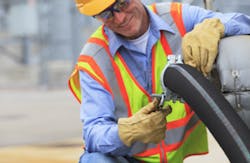RELATED: Read Part I in the "Troubleshooting Operational Issues" Series
RELATED: Read Part II in the "Troubleshooting Operational Issues" Series
RELATED: Read Part III in the "Troubleshooting Operational Issues" Series
RELATED: Read Part IV in the "Troubleshooting Operational Issues" SeriesRELATED: Read Part V in the "Troubleshooting Operational Issues" Series
The following article is the latest in a series based on troubleshooting a mysterious unit shutdown due to flowmeter performance problems.
Last month I suggested the hypothesis that liquid ammonia enters the unit with bubbles, causing the liquid ammonia ultrasonic flowmeter to break its ultrasonic circuit, incorrectly measure zero flow, and (in turn) cause the reactor to scram (shut down) (Flow Control, July 2014, page 10). Installing a section of jacketed pipe to cool the liquid ammonia upstream of the flowmeter reduced the number of scrams substantially.
Based on this information, the working theory was that in warm weather liquid ammonia entered the unit with bubbles of gas. Cooling the liquid ammonia reduced its vapor pressure, thereby condensing some of the bubbles, reducing the amount of gas reaching the flowmeter, and reducing the number of scrams.
Cooling the liquid ammonia in the jacketed pipe located upstream of the ultrasonic liquid ammonia flowmeter was expected to eliminate some scrams because less gas would be present. This is consistent with the observed reduction in the number of scrams that occurred after installing the cooler, as well as the fact that the scrams only occurred on the warmest days.
Using a section of jacketed pipe to cool the liquid ammonia was a pragmatic solution that greatly improved the operation, but did not really solve the problem. Installing a larger cooler was considered as a potential “brute force” solution—albeit with a considerable installed cost and energy penalty.
Solving the problem by insulating the 200 meters of piping in the pipe bridge was deemed to be not economically viable.
We’ll investigate more twists and turns next month…
RELATED: Read Part VII in the "Troubleshooting Operational Issues" Series
RELATED: Read Part VIII in the "Troubleshooting Operational Isssues" SeriesRELATED: Read Part IX in the "Troubleshooting Operational Isssues" Series
RELATED: Read Part X in the "Troubleshooting Operational Isssues" Series
David W. Spitzer is a regular contributor to Flow Control magazine and a principal in Spitzer and Boyes, LLC offering engineering, seminars, strategic, marketing consulting, distribution consulting and expert witness services for manufacturing and automation companies. Spitzer and Boyes is also the publisher of the Industrial Automation Insider. Mr. Spitzer has more than 35 years of experience and has written over 10 books and 300 articles about flow measurement, instrumentation and process control.Mr. Spitzer can be reached at 845 623-1830 or www.spitzerandboyes.com. Click on the “Products” tab to find his “Consumer Guides” to various flow and level measurement technologies.
About the Author
David W. Spitzer
David W Spitzer’s new book Global Climate Change: A Clear Explanation and Pathway to Mitigation (Amazon.com) adds to his over 500 technical articles and 10 books on flow measurement, instrumentation, process control and variable speed drives. David offers consulting services and keynote speeches, writes/edits white papers, presents seminars, and provides expert witness services at Spitzer and Boyes LLC (spitzerandboyes.com or +1.845.623.1830).

